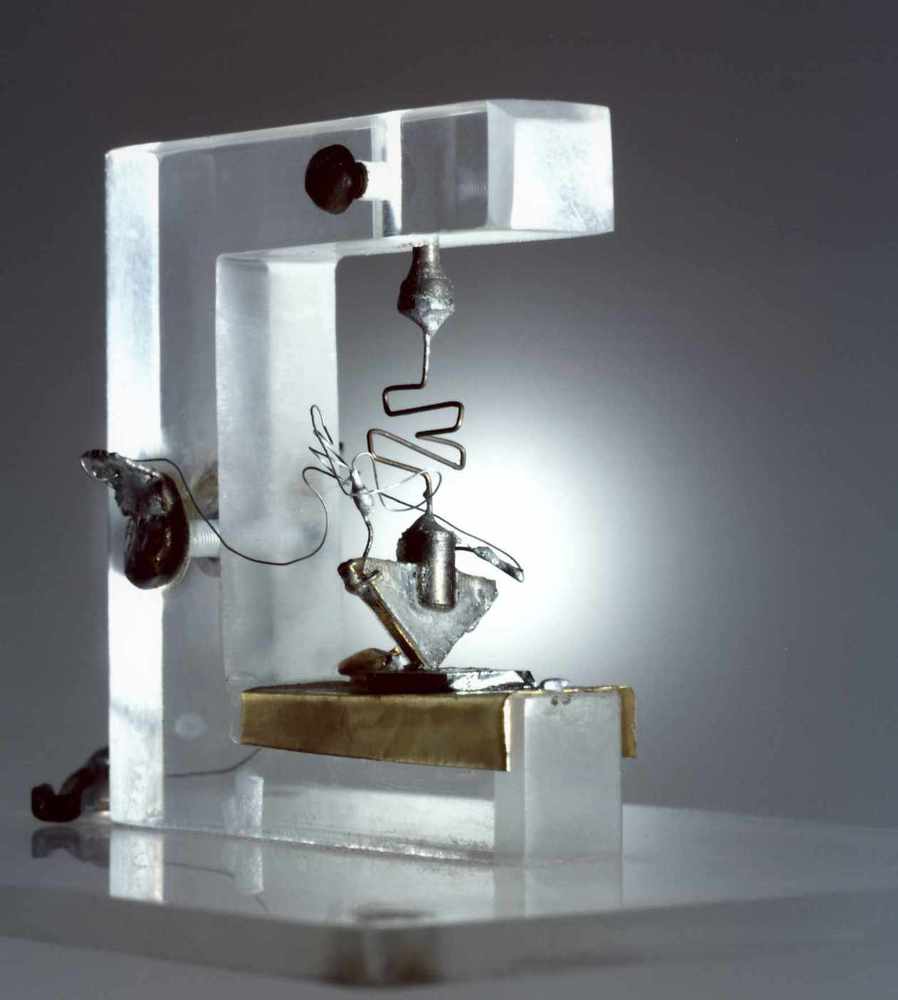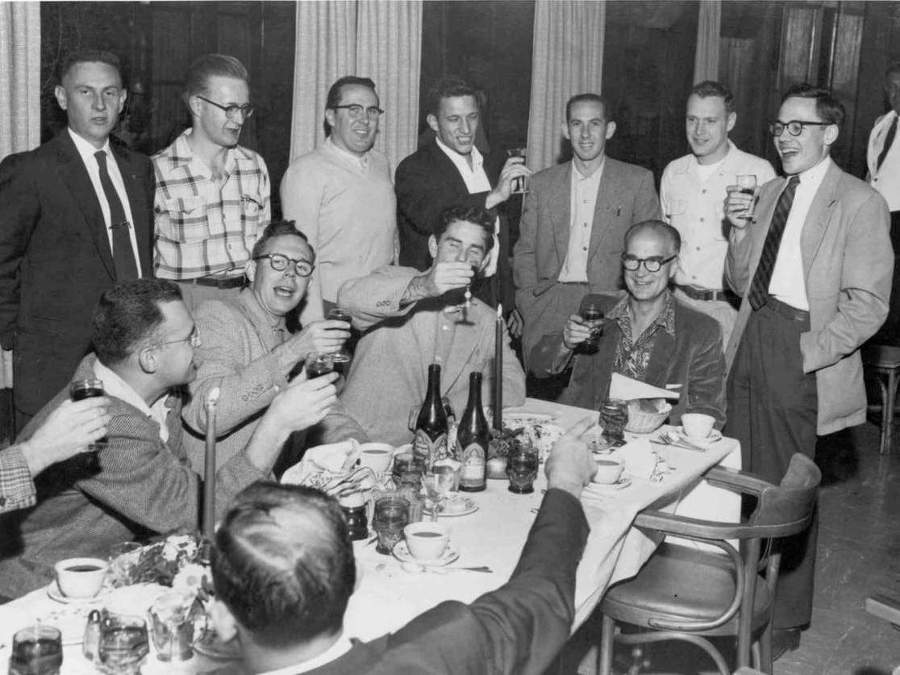VI. At Christmas 2013 Turing was posthumously granted a formal pardon by Queen Elizabeth II.

John Bardeen (1908–91), William Shockley (1910–89), and Walter Brattain (1902–87) in a Bell Labs photograph in 1948.

The first transistor at Bell Labs.

William Shockley (at head of table) the day he won the Nobel Prize being toasted by colleagues, including Gordon Moore (seated left) and Robert Noyce (standing center with wine glass) in 1956.
CHAPTER FOUR
THE TRANSISTOR
The invention of computers did not immediately launch a revolution. Because they relied on large, expensive, fragile vacuum tubes that consumed a lot of power, the first computers were costly behemoths that only corporations, research universities, and the military could afford. Instead the true birth of the digital age, the era in which electronic devices became embedded in every aspect of our lives, occurred in Murray Hill, New Jersey, shortly after lunchtime on Tuesday, December 16, 1947. That day two scientists at Bell Labs succeeded in putting together a tiny contraption they had concocted from some strips of gold foil, a chip of semiconducting material, and a bent paper clip. When wiggled just right, it could amplify an electric current and switch it on and off. The transistor, as the device was soon named, became to the digital age what the steam engine was to the Industrial Revolution.
The advent of transistors, and the subsequent innovations that allowed millions of them to be etched onto tiny microchips, meant that the processing power of many thousands of ENIACs could be nestled inside the nose cone of rocket ships, in computers that could sit on your lap, in calculators and music players that could fit in your pocket, and in handheld devices that could exchange information or entertainment with any nook or node of a networked planet.
Three passionate and intense colleagues, whose personalities both complemented and conflicted with one another, would go down in history as the inventors of the transistor: a deft experimentalist named Walter Brattain, a quantum theorist named John Bardeen, and the most passionate and intense of them all—tragically so by the end—a solid-state physics expert named William Shockley.
But there was another player in this drama that was actually as important as any individual: Bell Labs, where these men worked. What made the transistor possible was a mixture of diverse talents rather than just the imaginative leaps of a few geniuses. By its nature, the transistor required a team that threw together theorists who had an intuitive feel for quantum phenomena with material scientists who were adroit at baking impurities into batches of silicon, along with dexterous experimentalists, industrial chemists, manufacturing specialists, and ingenious tinkerers.
BELL LABS
In 1907 the American Telephone and Telegraph Company faced a crisis. The patents of its founder, Alexander Graham Bell, had expired, and it seemed in danger of losing its near-monopoly on phone services. Its board summoned back a retired president, Theodore Vail, who decided to reinvigorate the company by committing to a bold goal: building a system that could connect a call between New York and San Francisco. The challenge required combining feats of engineering with leaps of pure science. Making use of vacuum tubes and other new technologies, AT&T built repeaters and amplifying devices that accomplished the task in January 1915. On the historic first transcontinental call, in addition to Vail and President Woodrow Wilson, was Bell himself, who echoed his famous words from thirty-nine years earlier, “Mr. Watson, come here, I want to see you.” This time his former assistant Thomas Watson, who was in San Francisco, replied, “It would take me a week.”1
Thus was the seed planted for a new industrial organization that became known as Bell Labs. Originally located on the western edge of Manhattan’s Greenwich Village overlooking the Hudson River, it brought together theoreticians, materials scientists, metallurgists, engineers, and even AT&T pole climbers. It was where George Stibitz developed a computer using electromagnetic relays and Claude Shannon worked on information theory. Like Xerox PARC and other corporate research satellites that followed, Bell Labs showed how sustained innovation could occur when people with a variety of talents were brought together, preferably in close physical proximity where they could have frequent meetings and serendipitous encounters. That was the upside. The downside was that these were big bureaucracies under corporate thumbs; Bell Labs, like Xerox PARC, showed the limits of industrial organizations when they don’t have passionate leaders and rebels who can turn innovations into great products.
The head of Bell Labs’ vacuum-tube department was a high-octane Missourian named Mervin Kelly, who had studied to be a metallurgist at the Missouri School of Mines and then got a PhD in physics under Robert Millikan at the University of Chicago. He was able to make vacuum tubes more reliable by devising a water-cooling system, but he realized that tubes would never be an efficient method of amplification or switching. In 1936 he was promoted to research director of Bell Labs, and his first priority was to find an alternative.
Kelly’s great insight was that Bell Labs, which had been a bastion of practical engineering, should also focus on basic science and theoretical research, until then the domain of universities. He began a search for the country’s brightest young physics PhDs. His mission was to make innovation something that an industrial organization could do on a regular basis rather than ceding that territory to eccentric geniuses holed up in garages and garrets.
“It had become a matter of some consideration at the Labs whether the key to invention was a matter of individual genius or collaboration,” Jon Gertner wrote in The Idea Factory, a study of Bell Labs.2 The answer was both. “It takes many men in many fields of science, pooling their various talents, to funnel all the necessary research into the development of one new device,” Shockley later explained.3 He was right. He was also, however, showing a rare flash of feigned humility. More than anyone, he believed in the importance of the individual genius, such as himself. Even Kelly, the proselytizer for collaboration, realized that individual genius also needed to be nurtured. “With all the needed emphasis on leadership, organization and teamwork, the individual has remained supreme—of paramount importance,” he once said. “It is in the mind of a single person that creative ideas and concepts are born.”4
The key to innovation—at Bell Labs and in the digital age in general—was realizing that there was no conflict between nurturing individual geniuses and promoting collaborative teamwork. It was not either-or. Indeed, throughout the digital age, the two approaches went together. Creative geniuses (John Mauchly, William Shockley, Steve Jobs) generated innovative ideas. Practical engineers (Presper Eckert, Walter Brattain, Steve Wozniak) partnered closely with them to turn concepts into contraptions. And collaborative teams of technicians and entrepreneurs worked to turn the invention into a practical product. When part of this ecosystem was lacking, such as for John Atanasoff at Iowa State or Charles Babbage in the shed behind his London home, great concepts ended up being consigned to history’s basement. And when great teams lacked passionate visionaries, such as Penn after Mauchly and Eckert left, Princeton after von Neumann, or Bell Labs after Shockley, innovation slowly withered.